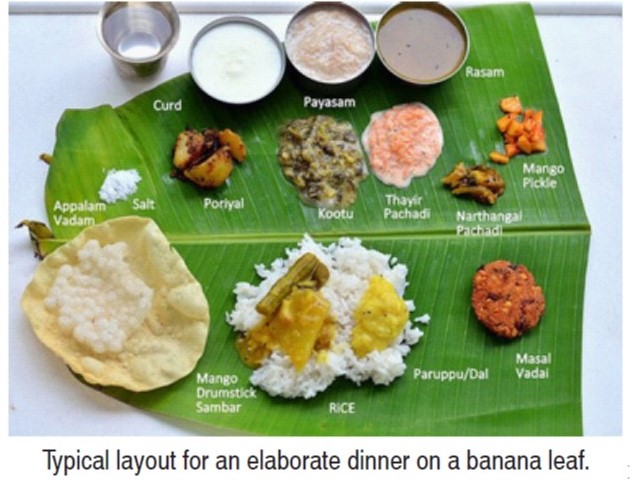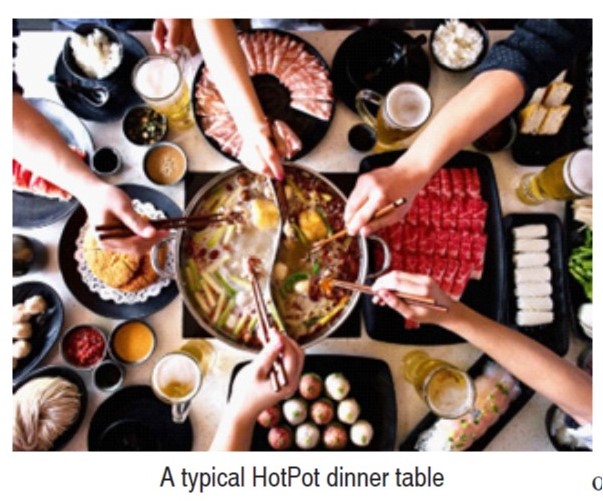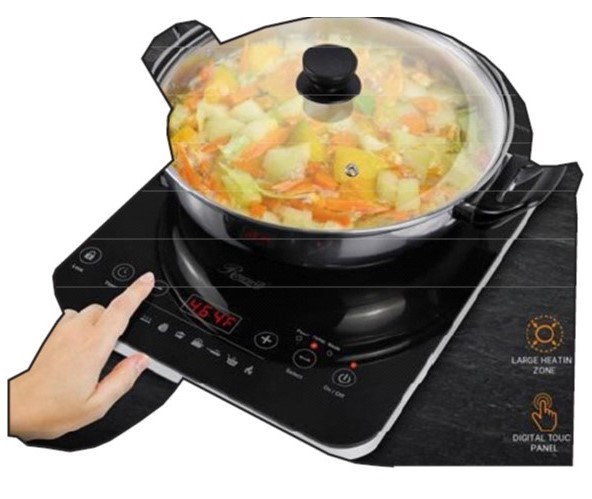European formal dinners follow dress codes and a system of what course follows which one and the array of silverware to eat the dishes.
Presentation, visual appeal of the meal, and the ambience, not to speak of the company we share the meals with, are as important as the variety and taste of the dishes served.
In the Middle East a shared plate fosters clan unity and cohesion. In the Sikh Gurudwara communal eating during the langar meal is an important part of their worship. Japanese platters are as decorative as they are appetizing, complementing colors and shapes with the taste of the dishes. Dramatic hibachi-made food conveys all the essence of a drama, with the chef posing as a Samurai warrior cutting meats and vegetables following strict protocols for the sizes and shapes, while showing off his dexterity with the ultra-sharp knife and forks.
In traditional wedding dinners in South India, even today there is an elaborate scheme for placing the different items on banana leaves. Each item — like salt, achars, banana chips, pappads, curries, dal items, raithas, and payasams (kheers), and cooked rice — in the sadhya (banquet) has a specific spot on the banana leaf layout. And you can start eating only when everybody’s banana leaf is served with all the items. Further, each item in the banquet, like sambaar, moru-koottan (similar to the North Indian kadi) rasam, and paayasams come in a specific sequence. Today’s buffet-style Indian wedding dinners with people filling their 10” dia plates with all items in one go and in one heap would be considered uncouth and barbarian.
In Chinese banquets, groups of people sit around a circular table ordering 10 to 20 items placed on a slowly rotating carousel in the middle. People take their seats following a strict hierarchy. As the items in large plates come to you on the slowly rotating carousel, using chopsticks, you pick whatever you like onto your eating bowl/plate.
The Chinese HotPot, whose history goes back over one thousand years, is another setup for sharing a meal in homes and in restaurants. The HotPot indulges and encourages the inner chef in you to mix and match and make your own very light broth, with your own combination of sauces and toppings. You thus create an aromatic, flavorful, spicy, and steaming hot mix in a large vessel kept right in front of you on the dinner table.
Then you add your choices of meats, vegetables, and noodles into the steaming hot broth and cook them till it is done. Everybody at the dinner table then helps themselves with the broth and the items they cooked into a smaller bowl and eat them slowly. Pre-made appetizers are served first.
I had heard of this cuisine from many but had not sampled it myself. We were in New York City during the Chinese New Year this January. We went to Chinatown for the festivities and completed it with a HotPot lunch on a cold winter day.
The menu card looked complicated with a wide array of meats, vegetables, noodles, and appetizers to choose from. First we decided on the most important item — the broth we would use to cook our chosen items. With a lot of help from our grandkids, who have already had the HotPot meals and loved them, we made our selections. We chose Sriracha-flavored broths with minced ginger and garlic and soy sauces. Then we were lead to a buffet with an array of toppings and sauces to mix and match to add to our broth. Some I recognized like Hoisin sauce and Sriracha but encountered some that I had not heard of. I made a selection of it on a plate and seated myself ready for the meal.
The waitress arrived with platters and platters of the items our family had chosen to add to the broth. So many vegetables, greens, meat slices, appetizers like tiny egg rolls, wontons, not to mention a variety of noodles.
Soon she turned on the induction heaters installed in the middle of the table with a range of options — simmer, low and medium heat, and boil at a typical HotPot dinner table — and placed large mixing bowls in the heater. She poured the steaming broths from kettles into the mixing bowls. We then added the vegetables and other items into the hot steaming broth and let them simmer and cook right in front of our eyes — we were our own cooks, sort of.
We were given small individual bowls to ladle out the steaming broth and cooked veggies into our bowls; after adding it with our thick sauce mix and toppings, the resulting uniquely concocted one-of-a-kind dish was ready to quell our appetite. Since it was flavorful and piping hot, it was a treat for our senses and so satisfying for a cold day outside. And it surely opened up our sinuses.
The waiter replenished the light broth as we emptied and we ate the vegetables and drank the light broth (much like the traditional south Indian rasam) to our hearts’ content. But much like eating the Vietnamese Pho, the HotPot meal filled us up with mostly water and vegetables. It was wholesome and satisfying.
Verily, this way of serving food is amazing in our times. A low-cal meal with healthy ingredients and minimum fat, at the same time flavorful, tasty, and spicy and satisfying to our palate. It is a rare combination.
Most big cities in North America have several HotPot restaurants Pittsburgh too has a few HotPot restaurants for you to explore, around the city and in Oakland.
If you are adventurous, you can easily setup your own HotPot dinner table for 4 to 6 people in your homes: the tabletop portable induction heater shown here is under $100, and a few other simple vessels and bowls. You can select all the Indian, Thai, and Italian spices and herbs you want to create your own one-of-a-kind broth create with your own array of green vegetables, roots, tofu, mushrooms, vadis, and noodles and meats (if you want)… And enjoy your HotPot dinner with your friends, with a glass of wine or a bottle of beer. ∎






